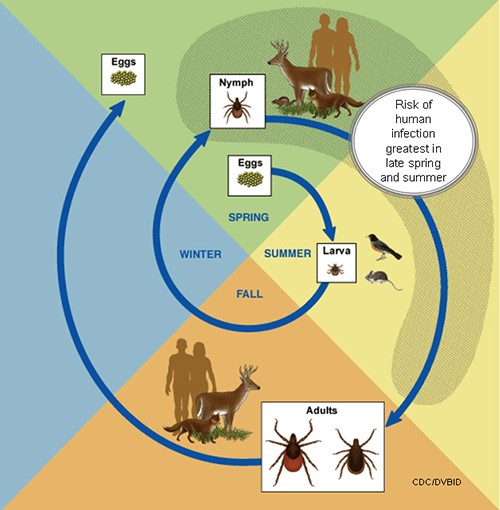Ticks have been making the headlines across national and local news outlets due to their resurgence and potential threats to your health and well being. We suggest that you prepare for ticks even if you have never found ticks in your yard or have been bitten. Just because it hasn’t happened yet doesn’t mean that it can’t happen in an instant. A combination of preventative steps you can take on your own with the aid of professional pest control is the best way to assure that you can enjoy your yard this summer without the worry of tick-borne diseases.
What attracts ticks to your yard?
In order to address tick pest control, you need to first understand what you’re up against. Follow this quick identification guide to learn about the most abundant ticks in New Jersey and Pennsylvania.

General tick identification chart Photo Credit: www.tickencounter.org
Lone Star Ticks
Lone star ticks are most abundant in the southeastern United States, which means you are not likely going to encounter one in New Jersey or Pennsylvania. That being said, there have been reports of the lone star tick throughout the East coast and as far North as Maine. These ticks can transmit serious tick-borne illnesses such as Rocky Mountain spotted fever, tularemia, tick paralysis, and STARI (southern tick-associated rash illness). Lone star ticks do not transmit Lyme disease.
Blacklegged (Deer) Ticks
Blacklegged ticks, commonly referred to as “deer ticks” are one of the most common carriers of Lyme disease. The nymphs are smaller than 1 inch and are responsible for transmitting this disease.

The lifecycle of a blacklegged tick Photo Credit: the CDC
American Dog Ticks
American dog ticks are most commonly found along roads and trails, using dogs as their preferred host. Humans can become targets if their pet were to bring the ticks indoors. Although they are the main transmitter of Rocky Mountain spotted fever, American dog ticks do not transmit Lyme disease.
Babesia
Blacklegged ticks can spread a disease called babesia, which is quickly becoming a problem in New Jersey and Pennsylvania. The blacklegged tick nymphs that transmit the infection are about the size of a poppy seed, so in most cases, the infected individual does not know they have babesia until symptoms surface weeks or even months later. Symptoms of babesia include, but are not limited to, chills, fever, headaches body aches, nausea, and fatigue. If left untreated, babesia can cause hemolytic anemia, a condition that causes red blood cells to be destroyed and removed from the bloodstream at quicker rate than normal.
Did my dog bring ticks inside or was it my yard?

Ticks need a host to survive. They live in tall grasses where they are concealed and can easily latch onto their victim. If your property is backed up to a wood line or you don’t regularly mow your lawn, it greatly increases your chances for tick activity. If your property has these elements, any host (dogs or humans) can fall prey to ticks, in turn bringing them indoors. If your dog was outdoors somewhere other than your property, there is a chance they can bring them back to your home. Dog parks, nature trails, and even walks around your neighborhood are common breeding grounds for ticks.
Deer and other wild animals are even more susceptible to ticks simply because they live outdoors and venture back and forth between your yard and the woods or other natural habitats. Even homes without wood lines can fall victim to tick activity through visits from these critters.
Tick-Borne Diseases
As the warm weather continues, the number of cases of tick diseases in 2018 continues to rise. Ticks find hosts such as animals and humans by hiding in tall grasses and shrubbery. By clinging onto the plant, ticks wait for a host to unknowingly brush up against them to cling on. Ticks cannot fly or jump, so hiding is how they find hosts. There are a series of tick-borne illnesses and diseases that are a cause for concern when it relates to humans and pets. Tick-borne illnesses often go unnoticed and spread quickly throughout the body without the chance to remediate. The following are the most common diseases transmitted by ticks, but not all of them. Read the “Can I get rid of ticks naturally?” section for information about preventing ticks.
Lyme Disease
Lyme disease can only be transmitted by blacklegged ticks. Unfortunately, blacklegged ticks are common in our immediate area of New Jersey and Eastern Pennsylvania. They hide in tall grasses and brush found in back yards, wooded areas, nature trails, parks, and other areas outdoors where vegetation is poorly maintained. It cannot be transmitted from human contact. For example, you cannot contract Lyme disease by sharing a drink with someone else with Lyme disease.
Symptoms of Lyme Disease
Lyme disease is transmitted through bacteria of an infested tick into the host’s skin. According to the CDC, blacklegged ticks typically lodge themselves in hard to see areas such as your scalp, groin, or armpits, making it all that more important to check for them after spending time outdoors.
The first signs that you might have Lyme disease is the development of a round, red rash with a bullseye shape. It can appear anywhere on the body and will expand over time if the tick is not removed and the person is not medically treated. Along with the classic red rash, Lyme disease can also cause headaches, muscle aches, fever, and chills. It’s important that you visit a medical professional immediately if you suspect that you have Lyme disease or exhibit the signs and symptoms of Lyme disease.
If left untreated, Lyme disease can cause effects such as joint swelling, speech problems, cognitive issues, muscle weakness, and abnormal muscle movement that lasts from months to years.
Rocky Mountain Spotted Fever
Rocky Mountain spotted fever is another tick-borne illness, resulting in the transmission of a bacterial infection. When left untreated, an individual with Rocky Mountain spotted fever can suffer from serious or even fatal damage to internal organs such as your kidney and heart. Individuals with Rocky Mountain spotted fever commonly exhibit a very distinct rash that looks like red splotches or spots. Unfortunately, it’s not always easy to diagnose Rocky Mountain spotted fever. A lot of the symptoms that come before a rash develops aren’t unique to this disease such as nausea, headache, vomiting, and muscle pain.
Powassan Virus
Powassan virus can be transmitted by the blacklegged tick; the same tick that spreads Lyme disease. Although it’s not common, Powassan virus is something that should be taken very seriously. Dr. Richard Cooper explains more about the Powassan virus in this excerpt from his update from May of 2017 which you can read here.
“It has recently made news headlines due to the potentially fatal nature of the disease and the fact that there is no known vaccinations or medications to treat the infected individuals. Fatalities from the disease occur in approximately 10% of the time, however among survivors nearly 50% suffer some type of permanent neurological effects, ranging from headaches, muscle deterioration, and memory loss.
What makes this disease so scary is the speed of transmission by ticks. Diseases like Lyme disease can be prevented simply by removing ticks with the first 24-36 hours after their mouthparts have been embedded into their host’s skin. In contrast, Powassan can be transmitted by ticks in less than 3 hours, and it is believed to be as short as 15-30 minutes after the tick’s mouthparts have been embedded. This leaves virtually no time for prevention of disease transmission by detecting and properly removing ticks before they have had the opportunity to inject the virus into their host through their blood feeding activity.”
How can I safely remove a tick?
The CDC outlines the following specific steps for removing a tick if you find one on yourself or a pet. Please do not attempt to remove a tick out any other way for safety reasons.
- Use fine-tipped tweezers to grasp the tick as close to the skin’s surface as possible.
- Pull upward with steady, even pressure. Don’t twist or jerk the tick; this can cause the mouth-parts to break off and remain in the skin. If this happens, remove the mouth-parts with tweezers. If you are unable to remove the mouth easily with clean tweezers, leave it alone and let the skin heal.
- After removing the tick, thoroughly clean the bite area and your hands with rubbing alcohol or soap and water.
- Never crush a tick with your fingers. Dispose of a live tick by putting it in alcohol, placing it in a sealed bag/container, wrapping it tightly in tape, or flushing it down the toilet.
Avoid folklore remedies such as “painting” the tick with nail polish or petroleum jelly, or using heat to make the tick detach from the skin. Your goal is to remove the tick as quickly as possible–not waiting for it to detach.
How can I get rid of ticks naturally?
According to the CDC, “Some insect repellent products for sale in the United States do not currently require EPA registration. In the 1990s, EPA evaluated the active ingredients in these unregistered products for safety (but not effectiveness). EPA determined that these all natural plant oils (like peppermint, thyme, eucalyptus, garlic, etc.) used in insect repellent products were safe for people and posed minimal risk to human health. EPA determined that products made from these all-natural ingredients do not require registration.”
This means that essential oils are approved as safe for skin application, but have not been tested by the EPA for effectiveness. Use extreme caution when relying on natural tick repellent and remedies to avoid ticks.
If you plan on venturing outside of your yard, choosing the proper tick repellent is paramount. Use the EPA’s repellent search tool to find the best repellent for you, factoring in things such as your length of time outdoors, the specific pest you need protection from, and more.
How does Cooper prevent ticks?
Yard Defender targets those areas of your property where ticks and mosquitoes are nesting, resting, breeding, and encroaching onto your property. If between service intervals, an unacceptable number of mosquito bites begin to occur, then Cooper will return to your house and render additional service at no additional cost! In most situations our four week interval will maintain the mosquito free environment, but if it fails you have the assurance of receiving as many FREE additional services as necessary to maintain your Bite Free Yard.
Cooper Pest Solutions provides tick control for residents in New Jersey and Eastern Pennsylvania. One of Cooper’s skilled technicians will assess your needs based on your property and the surrounding environment and target treatment in the areas where ticks are already present. This treatment will ideally begin in April but can be effective as long as it begins before fall. Our method is to treat the un-manicured areas around your home – mulch, groundcover, leaf litter, and any other overgrown area. We will also treat the perimeter of your yard and 5 feet into the turf which will prevent ticks from migrating into your yard. This treatment takes place in the spring, summer, and fall to ensure that you can enjoy your yard.
Pets and Kids
At Cooper, we know that it’s not necessary to treat your entire lawn for ticks. While many companies focus on trying to treat ticks by providing large-scale turf applications, Cooper knows that ticks live and breed in un-manicured areas around your home, and this is how we treat. Cooper’s methodology is much more effective and uses much less tick pesticides.
Call us at 1-800-949-2667 or fill out the form on this page for more information about tick control.











